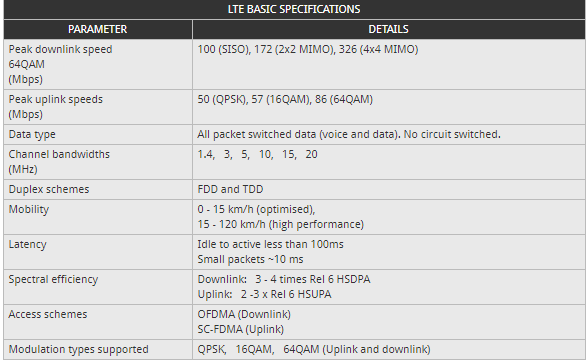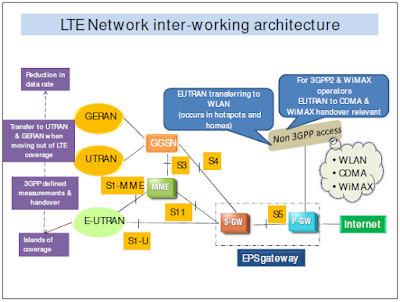LTE (Long Term Evolution) is a 4G wireless Technology which is developed by 3rd Generation partnership project (3GPP). LTE is a progression of previous cellular technologies i.e 2G (GSM) , 3G (UMTS). LTE has increased data rate of 100 Mbps downstream and 50 Mpbs upstream, scalable bandwidth capacity, backward compatibility with GSM and UMTS, simplified architecture, reduced cost per bit and reduced latency.
LTE uses different multiple access technologies. It uses OFDMA in downlink and SC-FDMA in uplink. These multiple access techniques provides high level of orthogonality which causes reduction in interference as there is high separation of subcarriers.
UMTS supports 5 Mhz bandwidth where as LTE supports different range of bandwidths i.e 1.4/3/5/10/15/20 Mhz. UMTS supports DS-CDMA as radio access technique where as LTE supports OFDMA in downlink and SC-FDMA in uplink. UMTS has uplink/downlink data rate of 384 kbps whereas LTE has 50Mbps in uplink and 100 Mbps in downlink.
LTE is an all IP based network which supports both IPv4 and IPv6.
3G and LTE comparison
LTE has very clear architecture as compared to 3G. In 3G there are separate PS and CS traffic where as there is a common packet core in LTE and LTE has clear separation of User plane and Control planes.Evolution of Cellular networks
The evolution from 1G to 4G depicts how data rates and technologies are changing and getting advanced.
LTE Architecture
In LTE Architecture, there are different end points like E-UTRAN air interface , S1 interface(eNB and EPC) and X2 interfaces(between eNB's), S-GW (serving Gateway), P-GW (Packet Gateway), MME (Mobility Management Entity) , GGSN, SGSN and interconnectivity with different networks.
High Data Rate in LTE
In LTE, there are different ways through which high data rates can be achieved. Like in release 8, the bandwidth can be about 20Mhz and in release 10, the bandwidth can be upto 100Mhz. Larger bandwidths can increase the capacities and thus increase the data rates. Multiple antennas and modulation techniques are other options that can increase data rates to high extent.
LTE Technologies
OFDM (Orthogonal frequency division multiplex) - The access schemes are OFDMA (Orthogonal frequency division multiple access in downlink while SC-FDMA is used in uplink. SC-FDMA has small peak to average power ratio and more constant power enables high RF power amplifier efficiency in the mobile handsets.
MIMO (Multiple input multiple output) - The problem with previous cellular systems was that multiple signals arising from many reflections that are encountered. By using MIMO, these additional signals can be used to get advantage and to increase the throughput. When using MIMO, it is essential to use multiple antennas to enable different paths. Multiple antenna metrics that are being used are 2x2, 4x2 and 4x4.
SAE (System Architecture Evolution) - With very high data rate and low latency requirements, it is necessary to evolve the system architecture to enable improved performance. In this way data can be routed more directly to its destination.
Within OFDMA signal, it is possible to select 3 types of Modulation
Types of Modulation for OFDMA Signal
QPSK - 2 bits/symbol
16 QAM - 4 bits/symbol
64 QAM - 6 bits/symbol
The OFDM symbols are grouped into resource blocks. The resource blocks have a total size of 180kHz in the frequency domain and 0.5ms in the time domain. Each 1ms Transmission Time Interval (TTI) consists of two slots (Tslot).
OFDMA Technology
The OFDM symbols are grouped into resource blocks. The resource blocks have a total size of 180kHz in the frequency domain and 0.5ms in the time domain. Each 1ms Transmission Time Interval (TTI) consists of two slots (Tslot).
SC-FDMA Technology
LTE uses a pre-coded version of OFDM called Single Carrier Frequency Division Multiple Access (SC-FDMA) in the uplink. This is to compensate for a drawback with normal OFDM, which has a very high Peak to Average Power Ratio (PAPR).
High PAPR requires expensive and inefficient power amplifiers with high requirements on linearity, which increases the cost of the terminal and drains the battery faster.
SC-FDMA solves this problem by grouping together the resource blocks in such a way that reduces the need for linearity, and so power consumption, in the power amplifier. A low PAPR also improves coverage and the cell-edge performance.

















No comments:
Post a Comment